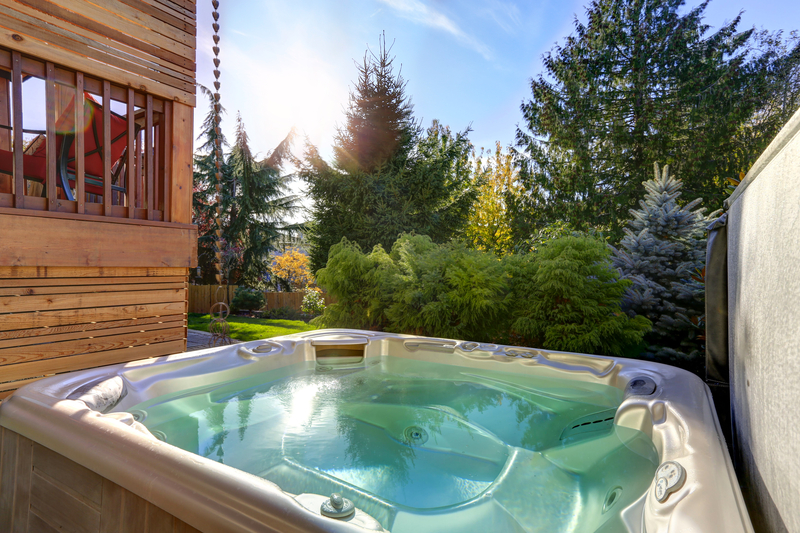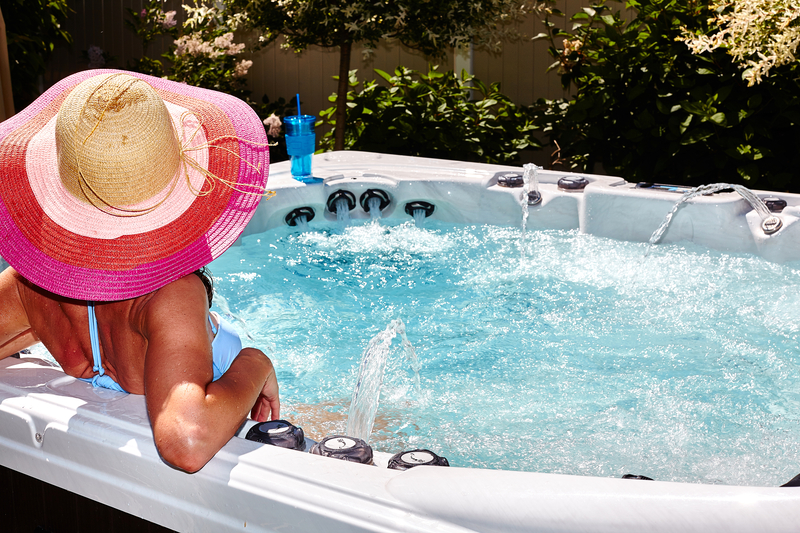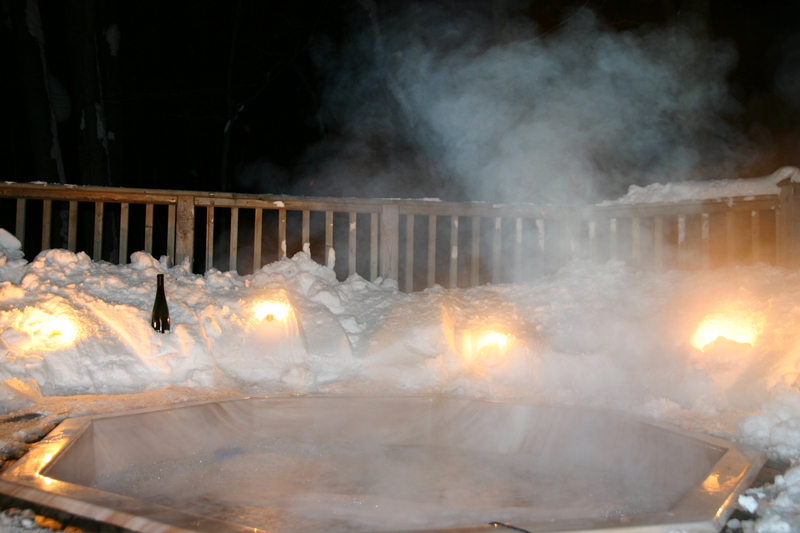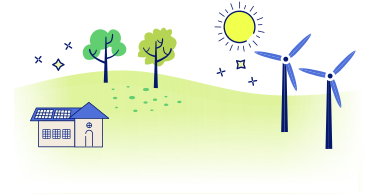This is your complete guide on answering the question – “how much electricity does a hot tub use?” There is no doubt that relaxing in a hot tub right in your backyard is something everyone dreams about. While of course, the luxuries of having a hot tub are rewarding, you can’t forget to look into hot tub electricity cost. That’s why in this article we are going to help you understand how much it will cost you to install a hot tub at your home!
On average, the cost to run a hot tub is around $20 to $60 per month, with the older models tending to cost more than the newer ones. However, modern hot tub manufacturers now offer more energy-efficient models that can cost as little as $1 a day to run.
Here at The Energy Professor, we want to give you the information you need to not only save money on your energy bill, but to also become more energy efficient. We hope find this post helpful! And makes it easier for you to know more about how much does a hot tub cost? Be sure to also check out our one-of-a-kind energy savings calculator!
The Energy Professor Electricity Rate Check Tool
How Much Power Does a Hot Tub Use 2024?

Having a hot tub on your property can make access to the life of luxury much easier, but you might want to ask yourself, “how much electric does a hot tub use?” A hot tub typically uses an average of 2,514 kilowatt-hours of energy per year. The energy consumption of a hot tub primarily goes into heating and circulating the water, with a small amount used for lighting. The specific power usage of a hot tub can vary depending on factors such as the size, model, age, and features of the hot tub.
Shockingly, while hot tubs use a lot less energy than they used to in the past, you can still expect your hot tub energy cost to be higher than you might think! Many popular manufacturers claim their hot tub electrical cost is only about $1 a day to run, which can be much higher or lower depending on the hot tub variety.
Hot Tub kWh Usage
When you decide to install a hot tub at your home, you might be wondering exactly how your hot tub electricity usage works. The most energy your hot tub uses is from the heater, which makes sense due to how hot the temperature of the water is in your jacuzzi. Between the varieties of heaters, we see hot tub energy consumption kWh between 1.5 kWh – 6 kWh (1500 watts – 6000 watts).
The average television consumes about 1 kWh of energy at about 1 hour of consumption a day for comparison.
Do hot tubs use a lot of energy?
If you use your hot tub every single day, or frequently, your hot tub energy use would be very high and cost you quite a bit. While that question can be subjective, you can expect there to be a rather large increase on your monthly electricity bill if you are running your hot tub every day. Even at the lowest wattage, you’re still adding about $30 to your electricity bill a month to maintain your hot tub.
Related post: Complete Guide on Solar Leasing
How Much Electricity Does a Hot Tub Tub Use Per Month 2024?

If you are looking into purchasing a hot tub, you will want to be aware of the hot tub electrical cost per month. It is completely normal to ask yourself, how much electric does a hot tub use a month when looking into making a new investment in a jacuzzi. As we learned in the previous section, just a 120-volt or 240-volt heater can pull between 1,500 watts to 6,000 watts of energy depending on the time of year. To compensate for any other necessary parts like pumps, lights or accessories, let’s assume another 1500 watts of hot tub electricity usage.
We also have to remember that just the electricity used to maintain the water temperature of your jacuzzi will be the lowest possible hot tub cost. When you are actively using your hot tub, the water pump will be running continuously, which means a higher energy bill.
How much does it cost to run a hot tub every month?
Now that we have our basic information, let’s figure out the electric cost for hot tub per month. For this equation, you will need to know the kWh rate your utility company charges (we will use the national average) the wattage of your heater, and how many hours you use it. We always say that a good rule of thumb is to budget between $20 – $40 a month to maintain and pay for your hot tub electric usage.
Here is a hypothetical hot tub electricity cost calculator with some common numbers you might see when using a small hot tub at your home.
- Small 120-volt heater – 2000 watts or 2 kWh
- Water pump – 1,500 watts or 1.5 kWh
- Average cost of kWh on electric bill – 14.77 cents
- Time spent in the hot tub
Add together the kWh for the accessories needed which comes out to be 3.5 kWh of energy per hour usage of your hot tub. On average, let’s estimate that a family might need to run a hot tub for 50 hours a month. To calculate jacuzzi electricity consumption, multiply 3.5 kWh by 50 to get 175 kWh of energy usage per month.
To then get the total hot tub cost, take 175 kWh and multiply that by the rate provided by your utility company, which we are using the national average, $14.77
The average cost to run your hot tub per month is about $26 with our equation, which can be much more or less depending on what you’re running. If your hot tub runs a 240-volt heater, running at 7.5 kWh, expect your jacuzzi electricity consumption to be just about double costing you about $50 per month.
How much electricity does a hot tub use per year?
By using our equation above, you can take how does a hot tub cost to run per month and multiply it by 12 to get your estimated yearly cost. With that being said, how much does a hot tub cost electricity per year? Our estimate shows that the average hot tub with a small heater could cost up to $310 a year.
Obviously, as we have been stating, your hot tub running cost could be much higher or lower depending on a variety of factors.
How much to run a hot tub in the winter?
Running a hot tub in the winter can help cure all of your chills especially when you sink into a bubbling hot jacuzzi with a view. Your hot tub winter cost can be exponential if your starting water temperature is below 60 degrees. It can take up to an extra 40 kWh to heat a hot tub from 50℉ to 100℉, and even more if your water is colder.
Even if you only use your hot tub a handful of times in the winter, heating it in colder temperatures can make your hot tub electricity usage cost you about $5 per use!
Related post: Complete Guide to the Best Time to Do Laundry
What Other Costs Come with Hot Tub Energy Usage?

As we mentioned above, your hot tub electricity cost can significantly vary depending on the different factors that come with your hot tub. We think when trying to calculate how much a hot tub costs in electricity it is important to outline all of the factors that can increase your electric bill.
Factors that affect cost of running a hot tub:
- Outdoor climate and temperature (air temp and wind speed)
- Size of hot tub
- Quality and age of hot tub
- Type and fit of hot tub cover
- Hot tub thermostat setting
- Age and quality of water heater
Each of these factors will have a major role in calculating how much it will cost to run your hot tub for any amount of time. One of the largest factors in hot tub energy cost is the size and how much water your tub holds. Remember, the more water in your tub, the more overall energy you use to heat it. It is also super important to keep on on maintenance and cleaning of your hot tub. Poorly maintained parts can contribute to high hot tub electricity costs due to not working at their fullest potential and sucking energy.
How much does it cost to clean a hot tub?
As we mentioned, maintenance is a huge part of keeping a clean and efficient hot tub to make sure that you aren’t wasting any money due to faulty parts. The best way to reduce your hot tub energy usage is to keep up with all required cleanings and other required upkeep that comes with owning a jacuzzi. Many new hot tub owners do not consider that you have to drain and replace the water at least once a year, which requires an addition of chemicals to keep your water clean.
It is smart to budget an extra $100 a year, just in case, to preserve the quality of a brand-new hot tub. That includes any extra lighting that you might need to purchase, as well as, part replacement as necessary.
Related post: Complete Guide to the Best Electricity Saving Devices for Homes
Tips and Tricks on How to Save Money on Hot Tub Electricity Use 2024

If you think you are ready to commit to all of the extra hot tub energy costs, then we are happy to inform you that there are things you can do to keep your cost of hot tub electricity down. Luckily, many of these tips are things you should be doing or considering long before you start pricing out a hot tub for your home!
What are ways to help save energy with a hot tub?
- Get a good quality, well fitting cover – A good quality hot tub cover might set you back, but it is very important that you purchase a cover that has steam stoppers and fits perfectly on your hot tub.
- Use during the right time – Maybe you live in a colder climate and have to consider not running your hot tub during the winter. It also costs you more to run your appliances during peak hours, so try going for an evening soak rather than earlier in the day.
- Lower your thermostat – With a hot tub, hotter may be better, but to cut down on hot tub electricity, we suggest lowering your hot tub heater by a few degrees. You will see a rather noticeable effect on your electric bill afterward!
- Use a thermal blanket – Thermal blankets work extra hard to make sure that the heat stays in your tub and your heater doesn’t have to work at all to maintain temperatures.
- Keep your tub and filters clean – When filters are clogged, it puts an extra strain on your motor and heating elements which can cause a spike in electricity consumption. Make sure to replace your filter at least once a year on your hot tub!
Related post: Complete Guide on How to Lower Your Energy Bill: 8 Tricks to Reduce Your Energy Bill
What are the Most Energy Efficient Hot Tubs 2024?

Now that we know almost everything about at-home jacuzzis, you might be wondering what are the most energy efficient hot tubs? Of course, you can do everything right with your hot tub and potentially purchase a brand that might not be efficient, costing you more. The main components that make a hot tub energy efficient are the circulation system, pump, filter, heater, etc.
The main concern when looking for an energy-efficient hot tub would be focusing on tubs that meet the American National Standard for Residential Swimming Pools. Other things you might want to look out for when wanting to save hot tub energy costs when purchasing are:
- Two-speed pumps for a hot tub – run more efficiently than one
- Hot tubs made with high-density polyurethane foam – improve efficiency by holding heat the longest
Hot Tub Energy Use FAQ

Q: How much energy does a hot tub use per month?
A: Hot tub manufacturers claim that it only costs about $1 to run your hot tub a day, but claim it can be as much as $50 per month on the high end. Depending on how much you use your hot tub, the size of your hot tub, and the maintenance of the hot tub, that number can fluctuate.
Q: How much does a hot tub raise your electric bill?
A: You should expect to be paying at minimum, an extra $30 a month for a brand new hot tub with a small heather that is properly maintained. On the higher end, you could be paying up to $50 – $60 a month for your hot tub costs, so make sure you do your research. The cost of a hot tub can fluctuate significantly depending on so many factors, which all should be considered before making your purchase.
Q: How many watts does a hot tub use?
The most energy your hot tub uses is from the heater, which makes sense due to how hot the temperature of the water is in your jacuzzi. Between the varieties of heaters, we see hot tub energy consumption kWh between 1.5 kWh – 6 kWh (1500 watts – 6000 watts).
Do you Need Cheaper Electricity?
If you’ve taken the time to understand the information on your bill and discovered you’re paying more than you’d like for your electricity, have you looked around for a cheaper deal? The Energy Professor has a wealth of information on ways to save on your utilities, including details of top deals that could significantly reduce your monthly or quarterly electricity bills.
We hope you found this article helpful! If you are looking for ways to increase the energy efficiency and sustainability in your home be sure to take a look at all of the latest renewable energy options in your area. The Energy Professor helps residential and small business owners find qualified energy suppliers in New York, New Jersey, Pennsylvania, Texas, Ohio, Maryland, Illinois, and Massachusetts

